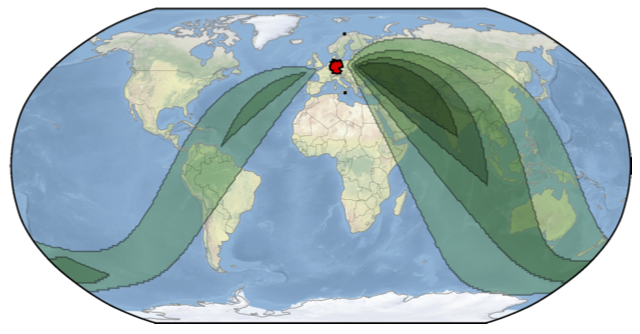ALIBI ROUTING
ABOUT
Users currently have little control over where in the world their packets
travel while en route to their destinations. Given recent events (censorship
of Internet traffic, suspicious "boomerang routing," and monitoring of users'
data), we seek to empower users with greater control.
We introduce Alibi Routing, a peer-to-peer system that allows users to understand and control where in the world their packets don't go. In other words, it lets users provably avoid parts of the world while communicating with others or browsing the web.
We introduce Alibi Routing, a peer-to-peer system that allows users to understand and control where in the world their packets don't go. In other words, it lets users provably avoid parts of the world while communicating with others or browsing the web.
HOW DOES IT WORK?
For detailed information, please view our
talk at SIGCOMM 2015
or check out the FAQ page. Below is a high-level description:
A user specifies two things: who they want to communicate with (the destination), and arbitrary "forbidden" geographic regions they wish to avoid while doing so. If successful, we return proof that the user's packets did not traverse the forbidden regions.
Alibi Routing then searches its peer-to-per network to locate other peers who can relay the user's packets while provably avoiding the forbidden region. We call such a peer an alibi.
Here's an example of a user in Italy trying to communicate with a server in Norway while avoiding Germany:

The green regions denote where alibis might exist. Alibi Routing searches these regions for alibis. If it can find one, then the user's packets are forwarded through the alibi. The user gets proof that the alibi avoided the region, if it was able to do so.
A user specifies two things: who they want to communicate with (the destination), and arbitrary "forbidden" geographic regions they wish to avoid while doing so. If successful, we return proof that the user's packets did not traverse the forbidden regions.
Alibi Routing then searches its peer-to-per network to locate other peers who can relay the user's packets while provably avoiding the forbidden region. We call such a peer an alibi.
Here's an example of a user in Italy trying to communicate with a server in Norway while avoiding Germany:

The green regions denote where alibis might exist. Alibi Routing searches these regions for alibis. If it can find one, then the user's packets are forwarded through the alibi. The user gets proof that the alibi avoided the region, if it was able to do so.
CODE AND DATA
The code and data from our SIGCOMM 2015 paper are available here:
- Code (27 KB): Contains our Alibi Routing prototype implementation and simulator. Instructions for building and running are provided in a README.
- Data (16 MB): Contains the data necessary to run the above code and to recreate the experiments in the paper. Includes topology information (country polygons).
- All (16 MB): Contains both the code and data releases.
PUBLICATIONS
| (pdf) |
Alibi Routing Dave Levin, Youndo Lee, Luke Valenta, Zhihao Li, Victoria Lai, Cristian Lumezanu, Neil Spring, Bobby Bhattacharjee ACM SIGCOMM 2015 |
PEOPLE
The following people have contributed to this project:
- Dave Levin (University of Maryland)
- Youndo Lee (University of Maryland)
- Luke Valenta (University of Pennsylvania)
- Zhihao Li (University of Maryland)
- Victoria Lai (University of Maryland; now at Palantir Technologies)
- Cristian Lumezanu (NEC Labs)
- Brendan Rowen (University of Maryland)
- Neil Spring (University of Maryland)
- Bobby Bhattacharjee (University of Maryland)
COVERAGE AND PRESS
United States:
- Podcast Interview, Packet Pushers, Oct 8, 2015
- The Route Less Traveled", Foreign Policy, Dec 10, 2015
- "Researchers unveil tool for dodging countries with Internet surveillance", The Christian Science Monitor, Aug 28, 2015
- "New Internet Routing Method Allows Users to Avoid Sending Data through Undesired Countries", Mono-live, Aug 27, 2015
- "Researchers create P2P Alibi Routing to avoid censorship and government surveillance", Network World, Aug 25, 2015
- "System Routes Internet Traffic Around Countries You Don't Trust", IEEE Spectrum, Aug 24, 2015
- "Cyber Week in Review: August 21, 2015", Council on Foreign Relations, Aug 21, 2015
- "Researchers can steer your emails away from hostile nations", engadget, Aug 20, 2015
- "'Alibi Routing' System to Give Internet Users More Control Over Their Data", Gadgets 360, Aug 19, 2015
- "New Internet Routing Method Allows Users to Avoid Sending Data Through Undesired Geographic Regions", Univ. of Maryland, Aug 18, 2015 (Picked up by Phys.Org, Science Daily, and Communications of the ACM)
- "'Alibi Routing': Peer-to-Peer-Technik zur Nutzer-Kontrolle des Datenverkehrs ("'Alibi routing': peer-to-peer technology for user-traffic control"), Heise Online (German), Oct 12, 2015
- "Alibi Routing: Neue Technik ermöglicht Länderausschluss beim Datenverkehr" ("Alibi Routing: New technology allows countries excluding the traffic"), Wirtschafts Woche (German), Oct 12, 2015
- "Peer-to-Peer-Netz prüft mit Lichtgeschwindigkeit: Forscher kämpfen mit Physik gegen Zensur" ("Peer-to-peer network checks the speed of light: Researchers contend with physics against censorship"), IP Insider (German), Sep 14, 2015
- "Pesquisadores criam mecanismo para evitar censura e vigilância de governos ("Researchers create mechanism to prevent censorship and surveillance of governments"), IDGNOW! (Portuguese), Aug 26, 2015
- "Dieses Plugin soll helfen, Internet-Zensoren auszutricksen ("This plugin is designed to help outsmart Internet censors"), Wired (German), Aug 20, 2015
- "Alibi Routing направит данные в обход проблемных стран ("Alibi Routing send data to bypass the problem countries"), KO (Computer Review) (Russian), Aug 19, 2015
- "Alibi Routing: Un nouveau routage internet pour éviter la censure" ("Alibi Routing: A new internet routing to avoid censorship"), Actualité Houssenia Writing (French), Aug 19, 2015